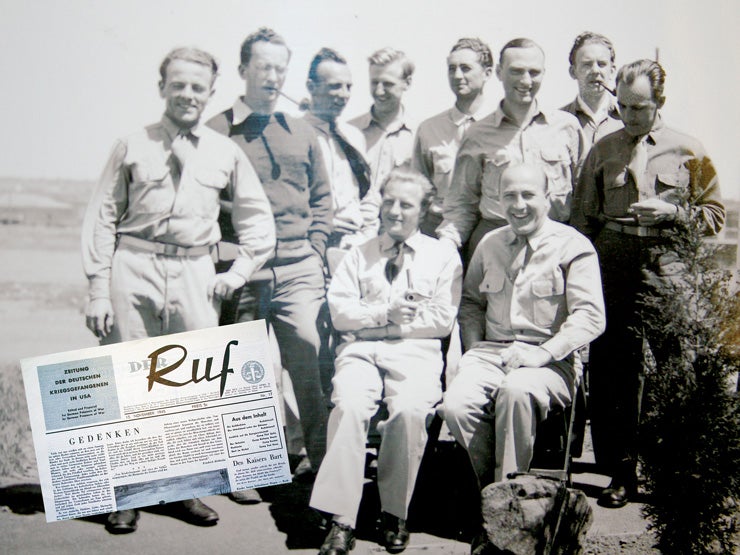The Secret POW Camp That Fought Nazi Ideology
In an amazing and little known chapter of World War II, a prisoner-of-war camp called The Idea Factory sought to change the hearts and minds of German prisoners—using other German prisoners. The classified mission to spread democracy took place right here at what is now URI’s Bay Campus.
By Paul E. Kandarian
The part Rhode Island played in World War II, most notably Quonset Point in North Kingstown, is no secret.
But just down the road in Narragansett, on waterfront land now home to the University of Rhode Island’s Bay Campus, was an installation that until recently was a forgotten appendix to the Second World War: Fort Kearney, which from February 1945 to April 1946 was a German prisoner-of-war camp.
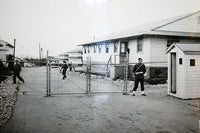
Why isn’t this common knowledge? Well, it was hardly the usual POW outfit. Originally built in 1908 as part of the state’s coastal defense sites, Fort Kearney became a top-secret operation under the federal Prisoner of War Special Projects Division. At the time, some 380,000 captured German soldiers were housed in U.S. camps. The project, an attempt to leverage that fact, was called “The Idea Factory,” later shortened to the Ludlumesque “The Factory.” It was charged with the daunting task of “de-Nazifying” POWs.
The idea: Military officials rounded up the most intellectually elite prisoners they could find, including teachers, professors, artists, writers and editors, many of them conscripted as soldiers against their will and already critical of Hitler. The sympathetic POWs were to help re-educate their fellows across the country via the publication of a POW newspaper, Der Ruf (The Call in English).
That effort’s rich history is laid out in a fascinating 8,000-word article, “The Top Secret World War II Prisoner-of-War Camp Kearney in Narragansett,” by Christian McBurney and Brian Wallin. The article can be read at their aptly named website, smallstatebighistory.com.
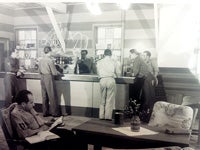
“I had never heard of it before until Brian brought it to my attention,” McBurney, a Kingston native, says from his law office in Washington, D.C. “I was fascinated.”
Der Ruf was produced and written at Fort Kearney, printed in New York City, then distributed to hundreds of other POW camps. The Rhode Island camp was a “casual place,” from which no one wanted to escape, McBurney says, because “all the prisoners were on board with the concept of re-education and preparing other Germans to return to a new Germany based on democracy and respect for human rights.”
On their website, McBurney and Wallin detail how it came into being. “With barracks, a kitchen and administrative buildings already in place, and with grounds shielded from public views, Special Projects Division inspectors liked what they saw and on Feb. 27, 1945, Fort Kearney was reclassified. Almost immediately, the special prisoners were transferred to the new location.”

A group of 85 prisoners all passed evaluations confirming their anti-Nazi bent—some had spent time in Nazi concentration camps. Several later rose to become influential postwar writers and thinkers, including Alfred Andersch and Hans Werner Richter, who were key players in Gruppe 47, an association formed in 1947 that for 20 years was a famous part of Germany’s postwar literary establishment.
But during the war, secrecy was paramount. “Kearney’s commander, U.S. Army Capt. Robert L. Kunzig, was instructed to keep the camp’s role secret for several reasons,” say McBurney and Wallin. “For one, many Americans had lost loved ones in the war in Europe and understandably hated Germans. Fueled by Allied war propaganda, the public often did not distinguish between Nazis and other Germans. Thus, there was concern the public would express outrage upon learning that some prisoners were being coddled.”
While the camp was surrounded by barbed wire, it had no armed guards or towers, and Kunzig’s discipline was relaxed. The pair dug up a quote from the commander: “We had almost no problems at Kearney. Once in a while we’d have to sort of jack them up and make sure they kept their beds neat, try to keep it very military and correct. We had inspections, but at the same time there were no real pressures.”
No one escaped Kearney, and no one tried. POW Andersch later recalled that a loudspeaker on the mess hall roof woke them up every morning with a Duke Ellington version of “Lady Be Good.”
There was almost no interaction between POWs and local residents at first, although that would change after the war ended. “On occasion,” McBurney and Wallin write, “prisoners (presumably working in camp administration) would jump into Army trucks and be driven over the bridge to Jamestown and then travel by ferry to Newport to pick up supplies for their camp. On the ferries, they would socialize with the other passengers.”
“I know this was true at Kearney,” Kunzig is quoted as saying, “because I sent them.”
McBurney and Wallin’s meticulous research dug up gems such as this quote, from Saunderstown resident C. Michael Hazard, who was 14 when the POW camp at Kearney opened: “It was no secret to those of us who lived in its vicinity. I don’t remember seeing prisoners outside the camp, but I did get inside the facility on a regular basis and the prisoners appeared to be a happy, well-fed group. We used to go down to the camp, pay 10 cents and watch current movies with the prisoners.”
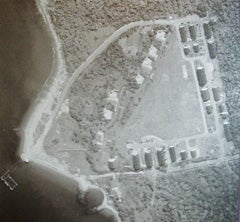
Another personal account the pair found: Charles “Ted” Wright’s family used to live at the corner of Boston Neck and Saunderstown roads, and as a 13-year-old, he and his brother snuck through the woods and up to the mesh fence around the fort to chat with POWs who spoke English. One gave them cigarettes until a U.S. officer shooed the boys away.
Wright said he saw POWs in prison clothes—stamped with PW—walking along Boston Neck Road to, he suspected, Twin Willows bar.
Lulu and Betty Sheldon, now 91 and 93, spoke with McBurney recently, recounting the days when they summered at the family’s shingle-style home in Saunderstown, right on the Bay, as college-age women. Officers would sometimes visit for dinner, and afterward, Capt. Kunzig would play the piano, Lt. Robert Pestalozzi the accordion, and everyone would sing along. All the officers they met spoke fluent German. An accomplished sailor, Lulu recounted how she was once sailing her 15-foot boat alone “when I came upon a man swimming far out from Fort Kearney. He said, ‘Guten tag!’ jovially, and I waved. Might he have used my sailboat to escape? Probably not, but it’s an amusing thought!”
The first issue of Der Ruf was sent to 134 POW camp canteens on March 6, 1945, priced at a nickel. “It created an immediate sensation,” McBurney’s research shows. “Nazis at a few camps bought the issues and burned them; at other camps, they threatened fellow prisoners who intended to purchase the newspaper. Yet prisoners at many other locations received the publication with overwhelming enthusiasm and responded by purchasing all of the copies at their camp canteens.”
One issue, intended to show that Americans were “not uncultured brutes as Germans had been taught,” had pages of excerpts from Benjamin Franklin, Thomas Paine, Walt Whitman, Abraham Lincoln, Thornton Wilder, and Thomas Wolfe. Another described the German tradition of free labor unions going back to the nineteenth century. Still others focused on the strengths of the American political system and culture.
“One interesting thing was that the government gave these men absolute carte blanche to communicate about American culture and democracy, with little censorship,” Wallin says. “They tried once; a guy came from Washington, which at the time wanted all Germans to accept responsibility for the Nazis, but the writers at the paper said ‘We’re not writing that, it’s not true.’ And the government backed down. That was surprising.”
After the war ended and German repatriation began, Der Ruf stopped publishing. Fort Kearney shut down in April 1946; the buildings went to Rhode Island State College, the forerunner of URI. In the short run, the barracks served as housing for graduate students and their families. Now expanded to more than 100 acres, the site houses URI’s renowned Graduate School of Oceanography.
The Fort Kearney story continues to be told; McBurney and Wallin give talks on the topic, and the Small State Big History staff is writing a book on Rhode Island in World War II, with Fort Kearney a vital chapter.
All of the camp’s POWs have since died, but the pair uncovered an account of Alfred Andersch’s 1970 tour of the Saunderstown countryside surrounding Fort Kearney. He found “old farms, weather-beaten frame houses surrounded by scrub oak and negligently harvested fields.” They must have been there when he was taken to the camp in “tarp-covered trucks” in 1945, he reflected, “yet strange to say I had always imagined the countryside around Fort Kearney exactly as I finally saw it on that day in October 1970.”
Andersch later reflected: “At the time, my old camp meant a great deal to me, everything in fact…After all, it was in the seclusion of Fort Kearney, after years of fear and trembling, that I decided to become a writer.” He also learned about democracy, in the “germ-free environment of that luxurious prison camp.
“The idea,” Andersch wrote, “appealed to me.”•
“ For more information, visit smallstatebighistory.com
Cultural Gatekeepers
The prisoners at Fort Kearney had several important missions beyond publishing Der Ruf. One was to monitor the newspapers and books proposed for use at other camps. Because about 85 percent of POWs nationwide spoke only German, they also acted as translators, both of classic U.S. novels—“They sold like hotcakes,” McBurney says—and of pamphlets describing North America’s institutions, history, and people.
Finally, The Factory inmates screened hundreds of radio programs and movies. They recommended against those that showed the dark side of American life, such as gangster films; and those they deemed overly propagandistic. They even advised not to show films with bad acting or poor plots, to forestall Nazi POW accusations that American culture was shallow.
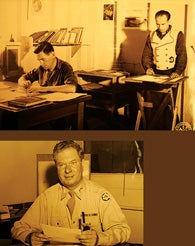
Top: POWs laying out Der Ruf. Bottom: Lt. Col. Edward Davidson, later a noted poet, led the US Special Projects Division. The unusual department of war was reportedly born of Eleanor Roosevelt’s outrage at reports of Nazi adherents bullying other POWS inside US camps.
An Obsession is Born
Brian Wallin first read about the secret POW camp in Walter Schroeder’s book, The Defenses of Narragansett Bay. He told McBurney, who was so captivated that he ended up devoting hundreds of hours to researching it, including trips to the National Archives and Yale University. “I enjoyed it,” McBurney says. “I have written a number of books—it keeps me busy!” Learn more at christianmcburney.com.
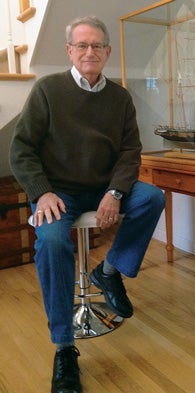
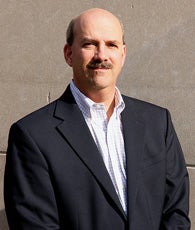
 Home
Home Browse
Browse Close
Close Events
Events Maps
Maps Email
Email Brightspace
Brightspace eCampus
eCampus



